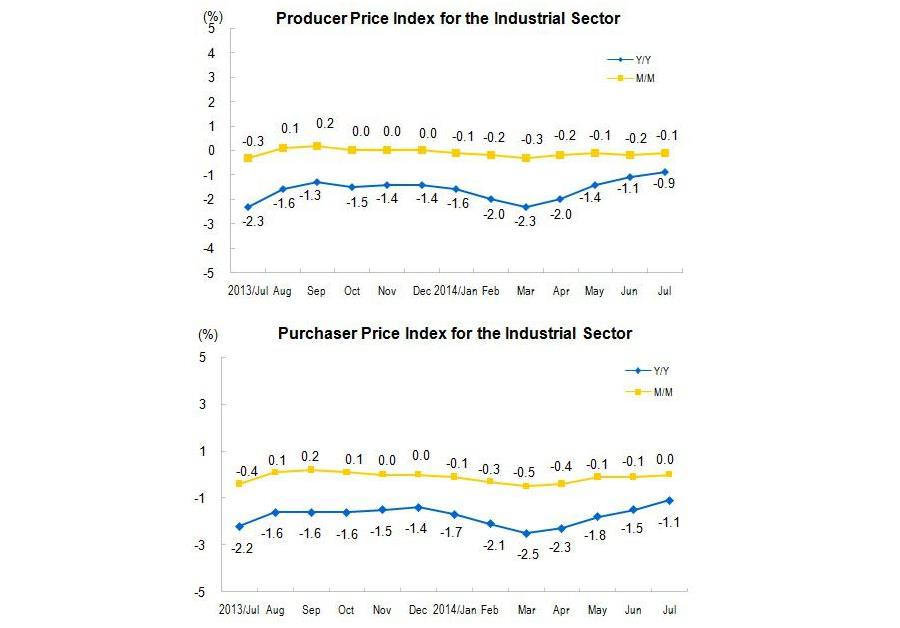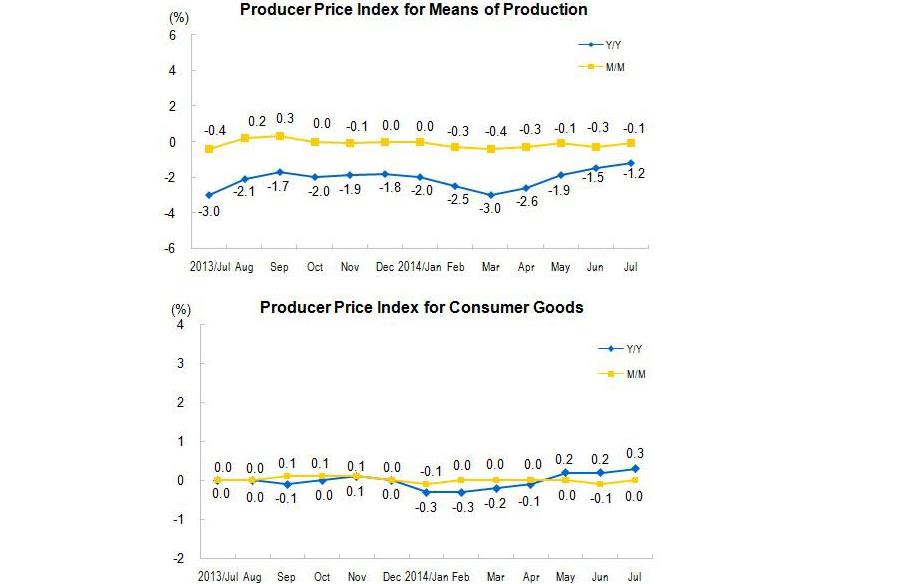In July 2014, Producer Price Index (PPI) for manufactured goods decreased 0.9 percent year-on-year, and decreased 0.1 percent month-on-month. The purchasing price index for manufactured goods went down by 1.1 percent year-on-year, and remained at the same level (the amount of change was 0, similarly hereinafter) month-on-month. On average from January to July, the PPI decreased 1.6 percent year-on-year, the purchasing price index for manufactured goods went down by 1.9 percent year-on-year.

1. Year-on-Year Changes of Prices of Different Categories
The year-on-year change of producer prices for means of production decreased 1.2 percent, meaning 0.92 percentage points decrease in the overall price level. Of which, producer prices for mining and quarrying industry decreased 3.4 percent; that of raw materials industry decreased 0.8 percent, that of manufacturing and processing industry decreased 1.2 percent. Producer prices for consumer goods increased 0.3 percent year-on-year, meaning 0.06 percentage points increase in the overall price level. Of which, producer prices for foodstuff and clothing both increased 0.7 percent, that of commodities went up by 0.4 percent, while that of durable consumer goods dropped 0.9 percent.

The year-on-year purchaser price indexes for ferrous metal materials decreased 4.1 percent, non-ferrous metal materials and wires, textile raw materials fell 1.1 percent, fuel and power decreased 1.0 percent, building materials and non-metallic increased 0.4 percent, agricultural and sideline products went up by 0.1 percent.
According to estimation, in the -0.9 percent decreases in July, the carryover effect of last year’s prices changing was 0.3 percentage points, while new prices rising factors in this year accounted for -1.2 percentage points.
2. Month-on-Month Changes of Prices of Different Categories
The producer prices for means of production decreased 0.1 percent month-on-month, meaning 0.09 percentage points decrease in the overall price level. Of the total, producer prices for mining and quarrying industry went down by 0.4 percent, that of raw materials industry increased 0.1 percent, that of manufacturing and processing industry decreased 0.2 percent. Producer prices for consumer goods remained at the same level month-on-month. Of which, producer prices for foodstuff, clothing, and commodities remained at the same level, and that of durable consumer goods decreased 0.1 percent.
The month-on-month purchaser price indexes for non-ferrous metal materials and wires went up by 0.9 percent, that of chemical raw materials went up by 0.3 percent, that of agricultural and sideline products increased 0.2 percent, that of ferrous metal materials decreased 0.6 percent, that of fuel and power decreased 0.3 percent.

Annotations:
1. Explanatory Notes
Producer Price Index for manufactured goods consists of producer price index and purchaser price index.
The industrial producer price index reflects the trend and level of prices change when the products are sold for the first time.
The industrial purchaser price index reflects the trend and level of prices change for the products purchased by the industrial enterprises as intermediate inputs.
2. Statistical Coverage
The statistical survey of industrial producer prices covers prices for over 11,000 products from 1702 subclasses, 191 groups; and the statistical surveys of industrial purchaser prices cover prices for over 6,000 industrial products from over 900 subclasses.
3. Survey Methods
Industrial producer prices are collected from combined surveys of key businesses and typical businesses. Starting from 2011, the key businesses are those with their turnover from primary activities over 20 million yuan, and the typical businesses are those with less than 20 million yuan. The surveys cover about 60,000 industrial enterprises in over 400 cities across the country.
4. Industrial Classification is based on the “Industrial Classification for National Economic Activities” (GB/T4754-2011).
